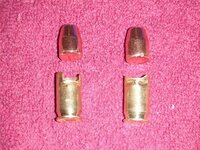- Messages
- 186
- Reactions
- 14
I just started loading .45 ACP for my 1911, and ran across an issue. After seating the bullets on the first two rounds just fine, the next two rounds didn't seat into the casing properly...one edge of the bullet just pushed/scrunched the casing as I was trying to seat it, and the copper jacket was marred as well.
I'm using Winchester once fired by me brass and Sierra 230gr JHPs, and yes, all my brass was sized, decapped, trimmed (if necessary), and inspected prior to priming and loading, and each bullet was inspected for any blemishes prior to loading. As for my setup, I'm using the following: Lee single stage press, Lee Carbide Pistol Dies (These are new), and Lee shell holder. Any ideas what would cause something like this? Needless to say I stopped loading until I can figure out what's going on.

I'm using Winchester once fired by me brass and Sierra 230gr JHPs, and yes, all my brass was sized, decapped, trimmed (if necessary), and inspected prior to priming and loading, and each bullet was inspected for any blemishes prior to loading. As for my setup, I'm using the following: Lee single stage press, Lee Carbide Pistol Dies (These are new), and Lee shell holder. Any ideas what would cause something like this? Needless to say I stopped loading until I can figure out what's going on.












